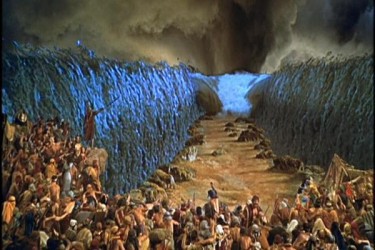Urban Jews Flee To iPhone-less Desert Wilderness For Passover

As a non-Jew who watched The Ten Commandments every Easter/Passover as a child and occasionally marries into Jewish families as an adult, I have been deeply disappointed with the reality of American Passover Seders. Expecting buckets of lamb blood for door painting and ominous bearded nomads reciting death tales from memory, instead I got people talking about college basketball around a glass-and-bronze dinette set piled high with unsavory seasonal items from the supermarket. That nobody at the table really believed in G-d never helped, either. How is He going to strike us all dead when he doesn’t even exist?
While there’s a lot more interesting food options for Pesach today — gelfite fish tacos, Turkish walnut cookies, Vietnamese sweet-chili salads, matzo ball pozole, banana-leaf wrapped barbecue beef brisket — you’re generally still stuck around the table with the same people talking about traffic and furtively glancing at their iPhones.
Why not pack up your few belongings in the night and flee to the harsh desert wilderness? You may not be at all surprised to learn that some Bay Area environmentalist Jews are doing just that for this year’s Passover.
The wilderness, in this case, consists of the vertigo-inducing peaks and plunges of the Panamint Valley, which runs alongside the better known Death Valley National Park and shares the same combination of icy mountains of gnarled conifers and scorching desert floors. There are no chariots full of bald Iranian actors to chase you, but there are scary suburban white people out for a weekend of “off roading,” and you’ll want to avoid them at all costs. (A pillar of dust from OHVs and meth fumes will be your warning that you have yet to reach the promised land of protected desert wilderness.) And once you’ve set up camp and night falls, Shabbat becomes a lot more exciting because it’s very dark out there, even if the full moon does kind of screw up the stargazing.
Last year, rabbinical student Mia Cohen of Ashland, Ore., went with her mother, and found that tensions between parents and their adult children disappeared in the clear desert air.
Passover in the desert, when the landscape is beginning to bloom, forces a question, Cohen said. Do you want to live in conflict, or to experience the freedom and renewal that surrounds you?
“We are literally seeing rebirth and making that choice for ourselves,” she said.
Literally! Also one way to get secular Jews to “reconnect” with their tradition is to drag ’em out into Nature to remind everybody that all spring religious festivals are actually about spring, the season of renewal. Pretty convenient that everything from Christ’s alleged resurrection to the escape from bondage in Egypt all correlates to the Northern Hemisphere’s natural orgy of flowers, rabbits ‘n eggs.
Wilderness Torah, the Berkeley group that does the Mojave Desert Passover campout, describes it like this:
Our village in the desert embodies simplicity, connection, tribe and transformation. We’ll leave our electronic devices at home as we make Exodus to the rugged desert wilderness, where we will experience the joy and abundance of living, eating, learning, singing, and praying together in the blooming spring desert.
We will gather for five days of village living and ceremony aimed at breaking down the personal barriers that hold us back from having true freedom in our lives.
The trek begins on March 28.
(And I swear to G-d I had never heard of this group or its outings when I wrote a little novel about a group of tech-weary people escaping the bondage of late Capitalism by fleeing to the Panamint Valley to hold ritual meals.)
